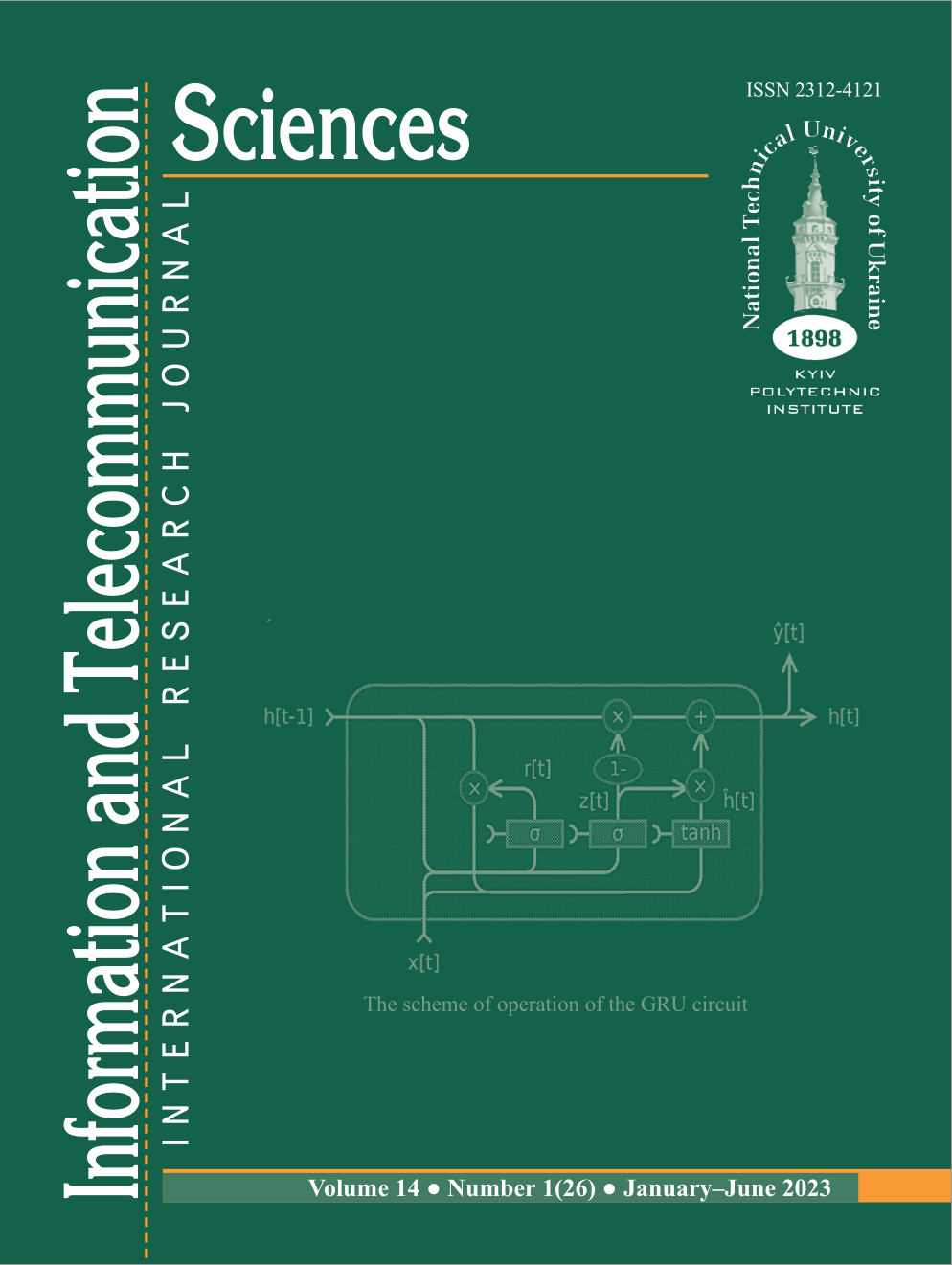COMPARISON OF OPTIMIZATION STRATEGIES AND ESTIMATION TECHNIQUES FOR RADIO NETWORK PLANNING AND OPTIMIZATION PROBLEMS
DOI:
https://doi.org/10.20535/2411-2976.12023.16-23Keywords:
radio network planning, radio network optimization, cellular networks, estimation techniques, optimization strategies, big data, 2G, 3G, 4G, CQI, capacityAbstract
Background. Radio network planning is one of the main phases of the cellular network lifecycle, as it determines capital and operating costs and allows system performance evaluation at any given time. An accurate and comprehensive analysis of existing network statistics is necessary for proper cell planning during network expansion. These statistics are collected throughout the life cycle of the cellular network and usually have certain imperfections (heterogeneity of statistics, which have different densities in different parts of the search space, up to the presence of significant voids, etc.) The system describing the functioning of the radio network can be represented as a black box because its internal processes are too complex to be defined by mathematical functions. This determines the need to use appropriate tools.
Objective. The purpose of the paper is to create a toolkit that allows finding the proper relationships between network parameters to define target values that will help to build an effective network plan in terms of performance and costs for its creation and operation. The tools should be able to work efficiently using the minimum set of available statistical data, as well as taking into account their imperfections.
Methods. Mathematical estimation and optimization methods are used, namely Ordinary Least Squares, Ridge Regression, Lasso, Elastic-net, LARS lasso, Bayesian Ridge Regression, Automatic Relevance Determination, Stochastic gradient descent, Theil-Sen estimator, Huber Regression, Quantile regression, Polynomial regression. We consider 12 estimation methods in combination with two optimization strategies. Additionally, the method of partial analysis of the search space with different number of configurations is considered.
Results. A software package using the Python programming language has been created, which contains a practical implementation of all the considered estimation and optimization methods, as well as tools for evaluating arbitrary configurations of the software package (benchmark) and visualizing the results. The best estimation method is Ordinary Least Squares for finding the optimal configuration of the statistical parameters of the 4G radio network to maximize the download speed. To obtain satisfactory results, it is enough to consider 25 initial and 250 estimated points - a larger number of points will not significantly increase prediction accuracy.
Conclusions. The results indicate the possibility of using the created software package for radio network planning tasks. Further research is aimed at expanding the created software package's functionality and considering additional estimation methods and optimization strategies.
Keywords: radio network planning; radio network optimization; cellular networks; estimation techniques; optimization strategies; big data; 2G; 3G; 4G; CQI; capacity.
References
Introduction to Optimization, chapter 1, pp. 1–56. John Wiley and Sons, Ltd, 2019.
James Bergstra and Yoshua Bengio. Random search for hyper-parameter optimization. Journal of Machine Learning Research, 13(10):281–305, 2012.
C. Lon Enloe, Elizabeth Garnett, Jonathan Miles, Physical Science: What the Technology Professional Needs to Know (2000), 47 p.
Fabian Pedregosa, Gaël Varoquaux, Alexandre Gramfort, Vincent Michel, Bertrand Thirion, Olivier Grisel, Mathieu Blondel, Peter Prettenhofer, Ron Weiss, Vincent Dubourg, Jake Vanderplas, Alexandre Passos, David Cournapeau, Matthieu Brucher, Matthieu Perrot, Édouard Duchesnay; 12(85):2825−2830, 2011.
Wooditch, Alese & Johnson, Nicole & Solymosi, Reka & Ariza, Juanjo & Langton, Samuel. (2021). Ordinary Least Squares Regression. 10.1007/978-3-030-50625-4_15.
Saleh, A.K.Md.Ehsanes & Arashi, M. & Kibria, B M Golam. (2019). Introduction to Ridge Regression. 1-13. 10.1002/9781118644478.ch1.
Zhang, Lijin & WEI, Xiayan & Lu, Jiaqi & Pan, Jun-Hao. (2020). Lasso regression: From explanation to prediction. Advances in Psychological Science. 28. 10.3724/SP.J.1042.2020.01777.
Regularization Path For Generalized linear Models by Coordinate Descent, Friedman, Hastie & Tibshirani, J Stat Softw, 2010
An Interior-Point Method for Large-Scale L1-Regularized Least Squares, S. J. Kim, K. Koh, M. Lustig, S. Boyd and D. Gorinevsky, in IEEE Journal of Selected Topics in Signal Processing, 2007
Efron, Bradley & Hastie, Trevor & Johnstone, Lain & Tibshirani, Robert. (2002). Least Angle Regression. The Annals of Statistics. 32. 10.1214/009053604000000067.
Neal, Radford & Neal, M. (2022). BAYESIAN LEARNING FOR NEURAL NETWORKS Bayesian Learning for Neural Networks.
Bishop, C & ligne, SpringerLink. (2006). Pattern Recognition and Machine Learning.
Stochastic Gradient Descent L. Bottou - Website, 2010.
Ohlson, James & Kim, Seil. (2013). Linear Valuation Without OLS: The Theil-Sen Estimation Approach. SSRN Electronic Journal. 20. 10.2139/ssrn.2276927.
Peter J. Huber, Elvezio M. Ronchetti: Robust Statistics, Concomitant scale estimates, 172 p.
Koenker, R. (2005). Quantile Regression (Econometric Society Monographs). Cambridge: Cambridge University Press. doi:10.1017/CBO9780511 754098
Downloads
Published
How to Cite
Issue
Section
License
Copyright (c) 2023 Volodymyr Prokopets, Larysa Globa

This work is licensed under a Creative Commons Attribution 4.0 International License.
The ownership of copyright remains with the Authors.
Authors may use their own material in other publications provided that the Journal is acknowledged as the original place of publication and National Technical University of Ukraine “Igor Sikorsky Kyiv Polytechnic Institute” as the Publisher.
ITS articles are published under Creative Commons licence:
- Authors retain copyright and grant the journal right of first publication with the work simultaneously licensed under CC BY 4.0that allows others to share the work with an acknowledgement of the work's authorship and initial publication in this journal.
- Authors are able to enter into separate, additional contractual arrangements for the non-exclusive distribution of the journal's published version of the work (e.g., post it to an institutional repository or publish it in a book), with an acknowledgement of its initial publication in this journal.
- Authors are permitted and encouraged to post their work online (e.g., in institutional repositories or on their website) prior to and during the submission process, as it can lead to productive exchanges, as well as earlier and greater citation of published work.

